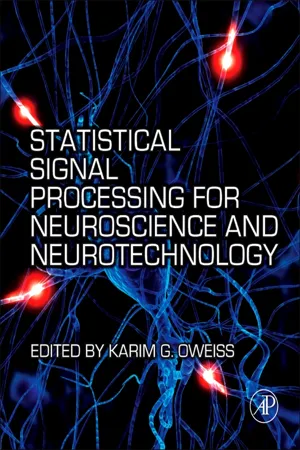
- 433 pages
- English
- ePUB (mobile friendly)
- Available on iOS & Android
Statistical Signal Processing for Neuroscience and Neurotechnology
About this book
This is a uniquely comprehensive reference that summarizes the state of the art of signal processing theory and techniques for solving emerging problems in neuroscience, and which clearly presents new theory, algorithms, software and hardware tools that are specifically tailored to the nature of the neurobiological environment. It gives a broad overview of the basic principles, theories and methods in statistical signal processing for basic and applied neuroscience problems.Written by experts in the field, the book is an ideal reference for researchers working in the field of neural engineering, neural interface, computational neuroscience, neuroinformatics, neuropsychology and neural physiology. By giving a broad overview of the basic principles, theories and methods, it is also an ideal introduction to statistical signal processing in neuroscience.- A comprehensive overview of the specific problems in neuroscience that require application of existing and development of new theory, techniques, and technology by the signal processing community- Contains state-of-the-art signal processing, information theory, and machine learning algorithms and techniques for neuroscience research- Presents quantitative and information-driven science that has been, or can be, applied to basic and translational neuroscience problems
Frequently asked questions
- Essential is ideal for learners and professionals who enjoy exploring a wide range of subjects. Access the Essential Library with 800,000+ trusted titles and best-sellers across business, personal growth, and the humanities. Includes unlimited reading time and Standard Read Aloud voice.
- Complete: Perfect for advanced learners and researchers needing full, unrestricted access. Unlock 1.4M+ books across hundreds of subjects, including academic and specialized titles. The Complete Plan also includes advanced features like Premium Read Aloud and Research Assistant.
Please note we cannot support devices running on iOS 13 and Android 7 or earlier. Learn more about using the app.
Information
Table of contents
- Cover
- Title Page
- Copyright
- Table of Contents
- Preface
- About the Editor
- About the Contributors
- Chapter 1: Introduction
- Chapter 2: Detection and Classification of Extracellular Action Potential Recordings
- Chapter 3: Information-Theoretic Analysis of Neural Data
- Chapter 4: Identification of Nonlinear Dynamics in Neural Population Activity
- Chapter 5: Graphical Models of Functional and Effective Neuronal Connectivity
- Chapter 6: State Space Modeling of Neural Spike Train and Behavioral Data
- Chapter 7: Neural Decoding for Motor and Communication Prostheses
- Chapter 8: Inner Products for Representation and Learning in the Spike Train Domain
- Chapter 9: Signal Processing and Machine Learning for Single-Trial Analysis of Simultaneously Acquired EEG and fMRI
- Chapter 10: Statistical Pattern Recognition and Machine Learning in Brain–Computer Interfaces
- Chapter 11: Prediction of Muscle Activity from Cortical Signals to Restore Hand Grasp in Subjects with Spinal Cord Injury
- Index